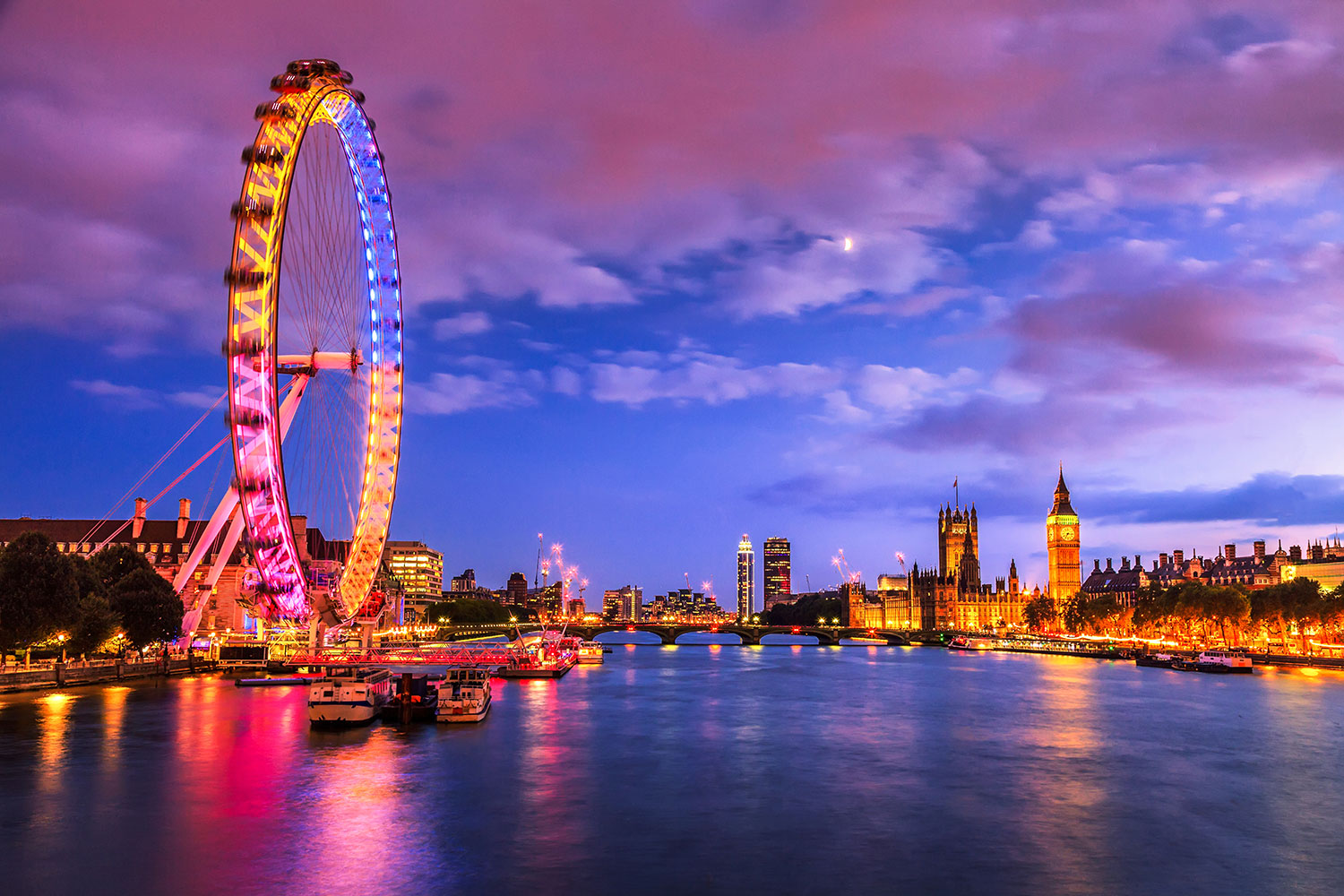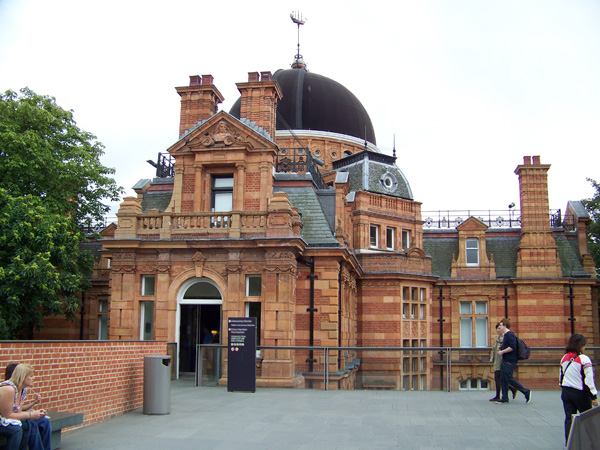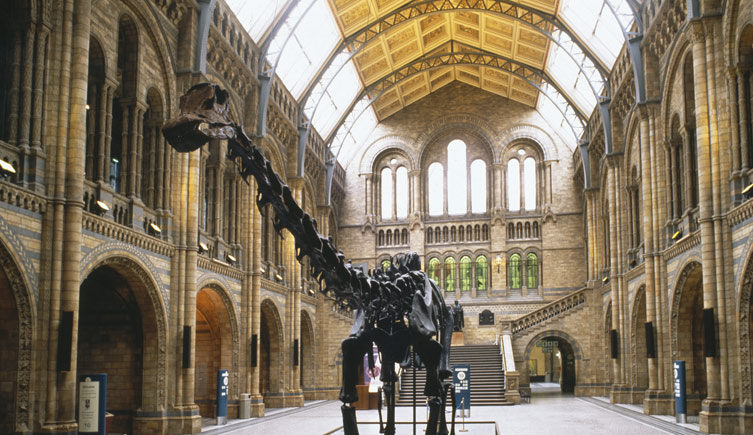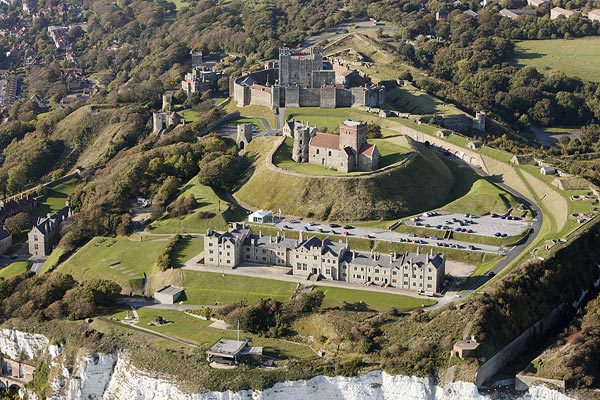1. Tower Bridge in London

Tower Bridge (built 1886-1894) is a combined bascule and suspension bridge in London, England, over the River Thames. It is close to the Tower of London, from which it takes its name. It has become an iconic symbol of London. The bridge consists of two towers tied together at the upper level by means of two horizontal walkways, designed to withstand the horizontal forces exerted by the suspended sections of the bridge on the landward sides of the towers. The vertical component of the forces in the suspended sections and the vertical reactions of the two walkways are carried by the two robust towers. The bascule pivots and operating machinery are housed in the base of each tower. The bridge’s present colour scheme dates from 1977, when it was painted red, white and blue for the Queen Elizabeth II’s silver jubilee. Originally it was painted a chocolate brown colour.
2. British Museum in London

The British Museum was established in 1753 when scientist Sir Hans Sloane donated his collection of 71,000 objects for preservation. It now has the most comprehensive collections in the world originating from all continents. The museum grew massively during the expansion of the British Empire. By the early 19th century, the British Museum had mostly housed sculptures from Greece and Egypt. It was after 1850 that the museum collected British and European medieval antiquities. Collections at the British Museum were also being diversified, collections from other continents were also added. The British Museum today has seven million object covering more than 6 acres of space. The museum has over 6 million visitors each year.
3. London Eye in London

London Eye is a giant Ferris wheel situated on the banks of the River Thames, in London, England. The entire structure is 135 metres (443 ft) tall and the wheel has a diameter of 120 metres (394 ft). It is the tallest Ferris wheel in Europe, and the most popular paid tourist attraction in the United Kingdom, visited by over 3.5 million people annually. When erected in 1999, it was the tallest Ferris wheel in the world, until surpassed first by the 160 m (520 ft) Star of Nanchang in 2006, and then the 165 m (541 ft) Singapore Flyer in 2008. It is still described by its operators as “the world’s tallest cantilevered observation wheel” (as the wheel is supported by an A-frame on one side only, unlike the Nanchang and Singapore wheels).
4. Tower of London in London

Her Majesty’s Royal Palace and Fortress, more commonly known as the Tower of London, is a historic castle on the north bank of the River Thames in central London, England. It lies within the London Borough of Tower Hamlets, separated from the eastern edge of the City of London by the open space known as Tower Hill. It was founded towards the end of 1066 as part of the Norman Conquest of England. The White Tower, which gives the entire castle its name, was built by William the Conqueror in 1078, and was a resented symbol of oppression, inflicted upon London by the new ruling elite. The castle was used as a prison since at least 1100, although that was not its primary purpose. A grand palace early in its history, it served as a royal residence. As a whole, the Tower is a complex of several buildings set within two concentric rings of defensive walls and a moat.
5. Stonehenge in Wiltshire
Stonehenge is indeed one of the most famous sites in the world. It is one of the numerous stone rings that exist in the British Isles. Stonehenge however is the most famous and most visited of them all. Archeologists believe that the site was constructed in three main stages, Stonehenge 1 (ca. 3100 BC), Stonehenge 2 (ca. 3000 BC) and Stonehenge 3 I (ca. 2600 BC). There has always been a debate on the use of Stonehenge. Previously, it was believed that its purpose was only for ritual purposes. However, it is now known that Stonehenge was also used as an astronomical observatory.
6. Dover Castle in Dover

Strategically located at the shortest crossing point to continental Europe, Dover Castle has been described as the ‘Key to England’ due to its defensive significance throughout history. It was built in the 12th century and is the oldest fortress in England. It is also one of the most famous fortresses in Europe. There are secret war time tunnels inside the Dover Castle, these are accessible through a tour guide. The tunnels were mostly used during World War II.
7. Royal Observatory Greenwich in London

The Royal Observatory Greenwich (formerly the Royal Greenwich Observatory or RGO), in London, England played a major role in the history of astronomy and navigation, and is best known as the location of the prime meridian. It is situated on a hill in Greenwich Park, overlooking the River Thames. The observatory was commissioned in 1675 by King Charles II, with the foundation stone being laid on 10 August. At this time the king also created the position of Astronomer Royal (initially filled by John Flamsteed), to serve as the director of the observatory and to “apply himself with the most exact care and diligence to the rectifying of the tables of the motions of the heavens, and the places of the fixed stars, so as to find out the so much desired longitude of places for the perfecting of the art of navigation.” The building was completed in the summer of 1676. The building was often given the title “Flamsteed House”. The scientific work of the observatory was relocated elsewhere in stages in the first half of the 20th century, and the Greenwich site is now maintained as a tourist attraction.
8. Radcliffe Camera in Oxford

The Radcliffe Camera (colloquially, “Rad Cam”; “Radder” in 1930s slang) is a building in Oxford, England, designed by James Gibbs in the English Palladian style and built in 1737 1749 to house the Radcliffe Science Library. The building is the earliest example in England of a circular library. It is built in three main stages externally and two stories internally, the upper one containing a gallery. The ground stage is heavily rusticated and has a series of eight pedimented projections alternating with niches. The central stage is divided into bays by coupled Corinthian columns supporting the continuous entablature. The pedimented windows stand above mezzanine openings, reflecting the interior arrangement. The top stage is a lanterned dome on an octagonal drum, with a balustraded parapet with vases.
9. Westminster Abbey in London
The Collegiate Church of St Peter at Westminster, popularly known as Westminster Abbey, is a large, mainly Gothic church, in the City of Westminster, London, United Kingdom, located just to the west of the Palace of Westminster. It is the traditional place of coronation and burial site for English, later British and later still (and currently) monarchs of the Commonwealth realms. The abbey is a Royal Peculiar and briefly held the status of a cathedral from 1540 to 1550. According to a tradition first reported by Sulcard in about 1080, the Abbey was first founded in the time of Mellitus (d. 624), Bishop of London, on the present site, then known as Thorn Ey (Thorn Island); based on a late tradition that a fisherman called Aldrich on the River Thames saw a vision of Saint Peter near the site. This seems to be quoted to justify the gifts of salmon from Thames fishermen that the Abbey received in later years. In the present era, the Fishmonger’s Company still gives a salmon every year. The proven origins are that in the 960s or early 970s, Saint Dunstan, assisted by King Edgar, installed a community of Benedictine monks here.
10. Natural History Museum in London

The Natural History Museum is one of three large museums on Exhibition Road, South Kensington, London, England (the others are the Science Museum, and the Victoria and Albert museum). Its main frontage is on Cromwell Road. The museum is an exempt charity, and a non-departmental public body sponsored by the Department for Culture, Media and Sport. The museum is home to life and earth science specimens comprising some 70 million items within five main collections: Botany, Entomology, Mineralogy, Palaeontology and Zoology. The museum is a world-renowned centre of research, specialising in taxonomy, identification and conservation. Given the age of the institution, many of the collections have great historical as well as scientific value, such as specimens collected by Darwin. The Natural History Museum Library contains extensive books, journals, manuscripts, and artwork collections linked to the work and research of the scientific departments. Access to the library is by appointment only.

